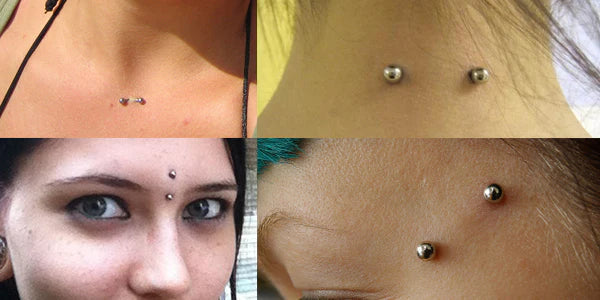Body piercings are a creative way to express individuality and style, and surface piercings take this art to a whole new level. If you're considering a unique way to adorn your body, surface piercings are worth exploring. In this blog, we'll delve into what surface piercings are, how they differ from traditional piercings, and the essential care tips to keep them looking lovely.
Understanding Surface Piercings
A surface piercing is a type of body piercing where the jewelry passes just beneath the skin’s surface, rather than through a piece of flesh such as an earlobe or nostril. Unlike traditional piercings that have entry and exit points on opposite sides of a body part, surface piercings rest parallel to the skin.
Common areas for surface piercings include:
- Collarbone
- Nape (back of the neck)
- Hips
- Chest
- Face (e.g., cheekbone or eyebrow area)
The jewelry used for surface piercings typically includes a surface barbell designed to reduce pressure and minimize the risk of rejection.
Surface Piercings vs. Dermal Implants
While surface piercings and dermal implants might appear similar, they are distinct. A surface piercing involves a barbell with two visible ends, while a dermal implant is a single-point piercing where only one end of the jewelry is visible.
Process of Getting a Surface Piercing
The process begins with selecting an experienced and licensed piercer, as this type of piercing requires precision. Here's what to expect:
- Preparation: The piercer will clean and mark the area to ensure the placement is even and aesthetically pleasing.
- Piercing: Using a sterile needle, the piercer creates a channel under the skin for the surface barbell.
- Jewelry Insertion: The surface bar is inserted into the channel, with the decorative ends visible on the skin’s surface.
The entire procedure is quick but requires expertise to minimize risks.
Healing and Aftercare
Surface piercings can take 6–12 months to heal, depending on placement and care. To ensure a smooth healing process, follow these aftercare tips:
- Clean Twice Daily: Use a saline solution or an aftercare product recommended by your piercer. Avoid harsh cleansers or alcohol-based products.
- Avoid Irritation: Keep the area free from friction caused by clothing or movement.
- Don’t Touch: Resist the urge to twist or fiddle with the jewelry, as this can introduce bacteria.
- Stay Hydrated and Healthy: Proper hydration and a balanced diet can help your body heal faster.
Risks of Surface Piercings
Surface piercings are prone to complications like rejection and migration. Rejection occurs when the body perceives the jewelry as a foreign object and pushes it out, while migration involves the jewelry shifting from its original placement. Choosing the right jewelry material, such as titanium or surgical-grade stainless steel, can help minimize these risks.
Why Choose a Surface Piercing?
Surface piercings are a bold statement, perfect for those who want a unique and eye-catching look. Whether you’re accentuating your collarbone or adding a touch of sparkle to your nape, surface piercings allow for endless creative expression.
Final Thoughts
Surface piercings are a beautiful way to showcase your style, but they require commitment to proper care and maintenance. If you're ready to embrace this distinctive piercing style, consult a trusted professional and follow their guidance for a safe and stunning result.
Ready to get inspired? Check out our collection of premium surface piercing jewelry at Pierced and Lovely to find the perfect piece for your new look!
